01-位运算-排序
1. 反码, 补码
- 正数,原码 == 反码 == 补码
- 负数
- 反码,除符号位取反
- 补码,反码 + 1
- 二进制没有减法运算,即计算机没有减法运算。(A原码 - B原码) == (A原码 + B补码) 即将时钟逆时针转动,转化为顺时针转动
- 10000000 => -0,00000000 => +0。出现两个0,而-0没有意义。所以就规定-0时候,储存数字为-128
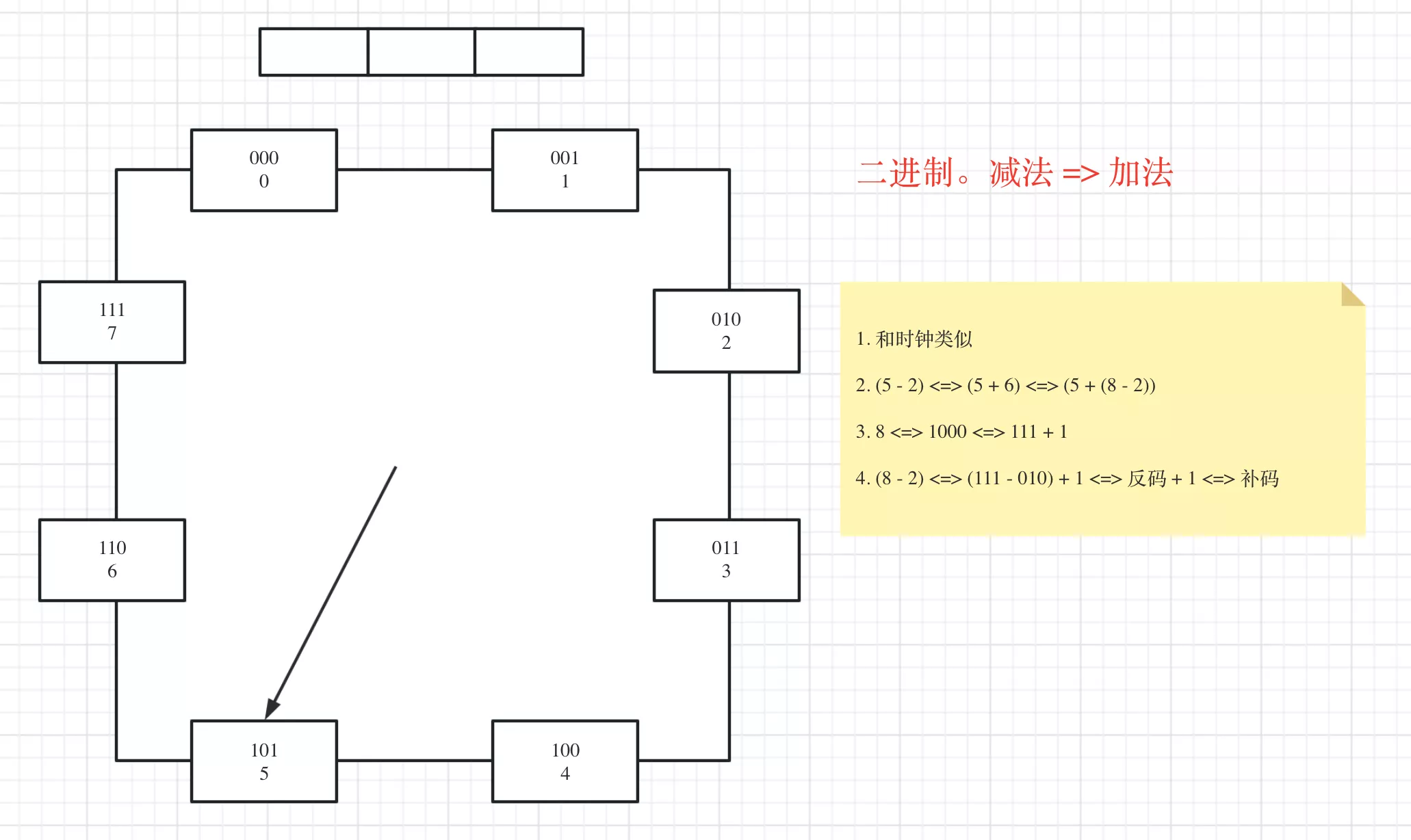
2. 位运算
public class _01_PrintBinary {
private static void print(int num) {
for (int i = 31; i >= 0; i--) {
// flag 位运算为0,或者其他10进制数
// 左移不带符号的,右移带符号的
int flag = num & (1 << i);
// System.out.print( flag == 1 ? "1" : "0"); 是错误的
System.out.print(flag == 0 ? "0" : "1");
}
System.out.println();
}
/**
* 打印int的底层二进制数
* int 4字节,32位。左移一位num * 2
*/
@Test
public void test1() {
int num = 1;
print(num); // 00000000000000000000000000000001
print(num << 1); // 00000000000000000000000000000010
print(num << 2); // 00000000000000000000000000000100
}
/**
* 整型最大值21亿多,01111111111111111111111111111111
* C++ 无符号整型 2^32 - 1
* java 有符号整型 (-2^31) ~ (2^31-1)
*/
@Test
public void test2() {
int maxValue = Integer.MAX_VALUE;
int minValue = Integer.MIN_VALUE;
// 2^31-1 (01111111111111111111111111111111)
System.out.println(maxValue);
print(maxValue);
// -2^31 (10000000000000000000000000000000)
System.out.println(minValue);
print(minValue);
}
/**
* 负数:取反 + 1
* 1. 通过首位确定符号
* 2. (取反 + 1) 按绝对值来算
*/
@Test
public void test3() {
print(-1); // 11111111111111111111111111111111
int minValue = Integer.MIN_VALUE;
print(minValue); // 10000000000000000000000000000000
int a = 1; // 00000000000000000000000000000001
int b = ~a; // 11111111111111111111111111111110
print(a);
print(b);
}
/**
* & | ~ ^ (与、或、取反、异或)
*/
@Test
public void test4() {
int a = 1;
int b = ~a;
print(a); // 00000000000000000000000000000001
print(b); // 11111111111111111111111111111110
System.out.println("=============");
int c = 12319283;
int d = 3819283;
print(c); // 00000000101110111111101000110011
print(d); // 00000000001110100100011100010011
System.out.println("=============");
print(c | d); // 00000000101110111111111100110011
print(c & d); // 00000000001110100100001000010011
print(c ^ d); // 00000000100000011011110100100000
}
/**
* 右移
*/
@Test
public void test5() {
int a = Integer.MIN_VALUE;
print(a); // 10000000000000000000000000000000
print(a >> 1); // 带符号右移 11000000000000000000000000000000
print(a >>> 1); // 不带符号右移 01000000000000000000000000000000
}
/**
* 相反数 (取反 + 1)
* 0 (取反 + 1 溢出舍弃,仍为0)
*/
@Test
public void test6() {
int c = Integer.MIN_VALUE;
// int d = ~c + 1;
int d = -c;
print(c); // 10000000000000000000000000000000
print(d); // 10000000000000000000000000000000
}
}
1. 两数比较
/**
* 返回两个数中较大的数
*/
public class _03_GetMax {
/**
* 取 (0, 1) 相反
*/
public static int flip(int n) {
return n ^ 1;
}
/**
* 判断一个数正、负
*/
public static int sign(int n) {
// (n >> 31) & 1 判断正、负
return flip((n >> 31) & 1);
}
public static int getMax1(int a, int b) {
int c = a - b;
int scA = sign(c);
int scB = flip(scA);
// (scA, scB) 一个为1,一个为0
return a * scA + b * scB;
}
public static int getMax2(int a, int b) {
int c = a - b;
int sa = sign(a);
int sb = sign(b);
int sc = sign(c); // 负值可能溢出
int difSab = sa ^ sb; // 异号1,同号0
int sameSab = flip(difSab);
// 同号:不可能溢出,大小取决于sc
// 异号:大小取决于sa正负
int returnA = difSab * sa + sameSab * sc;
int returnB = flip(returnA);
return a * returnA + b * returnB;
}
public static void main(String[] args) {
int a = 16;
int b = 19;
System.out.println(getMax1(a, b));
System.out.println(getMax2(a, b));
a = 2147483647;
b = -2147480000;
System.out.println(getMax1(a, b)); // wrong answer because of overflow
System.out.println(getMax2(a, b));
}
}
3. 算法
- 有具体的问题
- 有设计解决这个问题的具体流程
- 有评价处理流程的可量化指标(时间复杂度、空间复杂度)
分类:
- 明确知道怎么算的流程
- 明确知道怎么尝试的流程
1. 阶乘和
1! + 2! + 3! + 4! + … + N!
public class _02_SumOfFactorial {
/**
* 阶乘和, 算法一
*/
public static long f1(int N) {
long ans = 0;
for (int i = 1; i <= N; i++) {
ans += factorial(i);
}
return ans;
}
/**
* 阶乘算法
*/
public static long factorial(int N) {
long ans = 1;
for (int i = 1; i <= N; i++) {
ans *= i;
}
return ans;
}
// ---------------------------------------------
/**
* 阶乘和, 算法二
*/
public static long f2(int N) {
long ans = 0;
long cur = 1;
for (int i = 1; i <= N; i++) {
cur = cur * i;
ans += cur;
}
return ans;
}
/**
* 1! + 2! + 3! + 4! + … + N!
*/
public static void main(String[] args) {
int N = 10;
System.out.println(f1(N));
System.out.println(f2(N));
}
}
2. 排序
public class _03_Sort {
/**
* 数组交换元素
*/
public static void swap(int[] arr, int i, int j) {
int tmp = arr[j];
arr[j] = arr[i];
arr[i] = tmp;
}
/**
* 打印数组
*/
public static void printArray(int[] arr) {
for (int j : arr) {
System.out.print(j + " ");
}
System.out.println();
}
// ------------------------------------------------------
/**
* 1. 选择排序
*/
public static void selectSort(int[] arr) {
// 处理边界条件
if (arr == null || arr.length < 2) {
return;
}
// 0 ~ n-1
// 1 ~ n-1
// 2 ~ n-1
int N = arr.length;
for (int i = 0; i < N; i++) {
int minValueIndex = i;
for (int j = i + 1; j < N; j++) {
minValueIndex = arr[j] < arr[minValueIndex] ? j : minValueIndex;
}
swap(arr, i, minValueIndex);
}
}
// ------------------------------------------------------
/**
* 2. 冒泡排序
*/
public static void bubbleSort(int[] arr) {
if (arr == null || arr.length < 2) {
return;
}
// 0 ~ n-1
// 0 ~ n-2
// 0 ~ n-3
int N = arr.length;
for (int end = N - 1; end >= 0; end--) {
// 0 ~ end (相临元素比较)
// 0 1, 1 2, 2 3 ... end-1 end
for (int second = 1; second <= end; second++) {
if (arr[second - 1] > arr[second]) {
swap(arr, second - 1, second);
}
}
}
}
// ------------------------------------------------------
/**
* 3. 插入排序1(摸牌,新来一张牌)
*/
public static void insertSort1(int[] arr) {
if (arr == null || arr.length < 2) {
return;
}
// 0 ~ 0 完成
// 0 ~ 1
// 0 ~ 2
// 0 ~ 3
// 0 ~ n-1
int N = arr.length;
for (int end = 1; end < N; end++) {
int newNumIndex = end;
while (newNumIndex - 1 >= 0 && arr[newNumIndex - 1] > arr[newNumIndex]) {
swap(arr, newNumIndex - 1, newNumIndex);
newNumIndex--;
}
}
}
// ------------------------------------------------------
/**
* 4. 插入排序2(摸牌,新来一张牌)
*/
public static void insertSort2(int[] arr) {
if (arr == null || arr.length < 2) {
return;
}
int N = arr.length;
for (int end = 1; end < N; end++) {
for (int pre = end - 1; pre >= 0 && arr[pre] > arr[pre + 1]; pre--) {
swap(arr, pre, pre + 1);
}
}
}
public static void main(String[] args) {
int[] arr = {7, 1, 3, 5, 1, 6, 8, 1, 3, 5, 7, 5, 6};
printArray(arr);
insertSort2(arr);
printArray(arr);
}
}
1. 选择排序

public class _04_SelectionSort {
public static void selectionSort(int[] arr) {
if (arr == null || arr.length < 2) {
return;
}
for (int i = 0; i < arr.length - 1; i++) {
int minIndex = i;
for (int j = i + 1; j < arr.length; j++) {
if (arr[j] < arr[minIndex]) {
minIndex = j;
}
}
swap(arr, i, minIndex);
}
}
public static void swap(int[] arr, int i, int j) {
int tmp = arr[i];
arr[i] = arr[j];
arr[j] = tmp;
}
public static void comparator(int[] arr) {
Arrays.sort(arr);
}
// 随机数组
public static int[] generateRandomArray(int maxSize, int maxValue) {
// Math.random() [0,1)
// Math.random() * N [0,N)
// (int)(Math.random() * N) [0, N-1]
int[] arr = new int[(int) ((maxSize + 1) * Math.random())];
for (int i = 0; i < arr.length; i++) {
// [-? , +?]
arr[i] = (int) ((maxValue + 1) * Math.random()) - (int) (maxValue * Math.random());
}
return arr;
}
// for test
public static int[] copyArray(int[] arr) {
if (arr == null) {
return null;
}
int[] res = new int[arr.length];
System.arraycopy(arr, 0, res, 0, arr.length);
return res;
}
// for test
public static boolean isEqual(int[] arr1, int[] arr2) {
if (arr1 == null && arr2 == null) {
return true;
}
if (arr1 == null ^ arr2 == null) {
return false;
}
if (arr1.length != arr2.length) {
return false;
}
for (int i = 0; i < arr1.length; i++) {
if (arr1[i] != arr2[i]) {
return false;
}
}
return true;
}
// for test
public static void printArray(int[] arr) {
if (arr == null) {
return;
}
for (int j : arr) {
System.out.print(j + " ");
}
System.out.println();
}
// for test
public static void main(String[] args) {
int testTime = 500_000;
int maxSize = 100;
int maxValue = 100;
boolean succeed = true;
for (int i = 0; i < testTime; i++) {
int[] arr1 = generateRandomArray(maxSize, maxValue);
int[] arr2 = copyArray(arr1);
selectionSort(arr1);
comparator(arr2);
if (!isEqual(arr1, arr2)) {
succeed = false;
printArray(arr1);
printArray(arr2);
break;
}
}
System.out.println(succeed ? "Nice!" : "Fucking fucked!");
int[] arr = generateRandomArray(maxSize, maxValue);
printArray(arr);
selectionSort(arr);
printArray(arr);
}
}
2. 冒泡排序

public class _05_BubbleSort {
public static void bubbleSort(int[] arr) {
if (arr == null || arr.length < 2) {
return;
}
for (int end = arr.length - 1; end > 0; end--) {
for (int i = 0; i < end; i++) {
if (arr[i] > arr[i + 1]) {
swap(arr, i, i + 1);
}
}
}
}
// 交换arr的i和j位置上的值
public static void swap(int[] arr, int i, int j) {
int tmp = arr[i];
arr[i] = arr[j];
arr[j] = tmp;
}
// for test
public static void comparator(int[] arr) {
Arrays.sort(arr);
}
// for test
public static int[] generateRandomArray(int maxSize, int maxValue) {
int[] arr = new int[(int) ((maxSize + 1) * Math.random())];
for (int i = 0; i < arr.length; i++) {
arr[i] = (int) ((maxValue + 1) * Math.random()) - (int) (maxValue * Math.random());
}
return arr;
}
// for test
public static int[] copyArray(int[] arr) {
if (arr == null) {
return null;
}
int[] res = new int[arr.length];
for (int i = 0; i < arr.length; i++) {
res[i] = arr[i];
}
return res;
}
// for test
public static boolean isEqual(int[] arr1, int[] arr2) {
if ((arr1 == null && arr2 != null) || (arr1 != null && arr2 == null)) {
return false;
}
if (arr1 == null && arr2 == null) {
return true;
}
if (arr1.length != arr2.length) {
return false;
}
for (int i = 0; i < arr1.length; i++) {
if (arr1[i] != arr2[i]) {
return false;
}
}
return true;
}
// for test
public static void printArray(int[] arr) {
if (arr == null) {
return;
}
for (int i = 0; i < arr.length; i++) {
System.out.print(arr[i] + " ");
}
System.out.println();
}
// for test
public static void main(String[] args) {
int testTime = 500_000;
int maxSize = 100;
int maxValue = 100;
boolean succeed = true;
for (int i = 0; i < testTime; i++) {
int[] arr1 = generateRandomArray(maxSize, maxValue);
int[] arr2 = copyArray(arr1);
bubbleSort(arr1);
comparator(arr2);
if (!isEqual(arr1, arr2)) {
succeed = false;
break;
}
}
System.out.println(succeed ? "Nice!" : "Fucking fucked!");
int[] arr = generateRandomArray(maxSize, maxValue);
printArray(arr);
bubbleSort(arr);
printArray(arr);
}
}
3. 插入排序
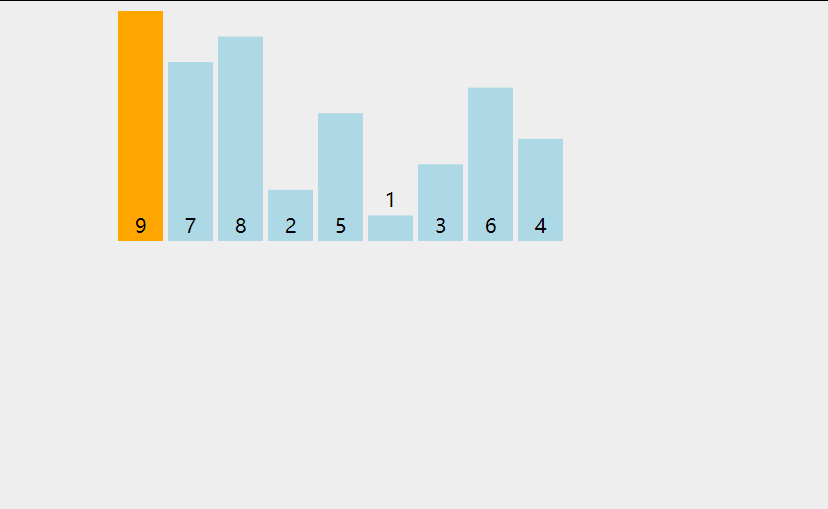
public class _06_InsertionSort {
public static void insertionSort(int[] arr) {
if (arr == null || arr.length < 2) {
return;
}
for (int i = 1; i < arr.length; i++) { // 0 ~ i 做到有序
for (int j = i - 1; j >= 0 && arr[j] > arr[j + 1]; j--) {
swap(arr, j, j + 1);
}
}
}
// i和j, 数交换
public static void swap(int[] arr, int i, int j) {
int tmp = arr[i];
arr[i] = arr[j];
arr[j] = tmp;
}
// for test
public static void comparator(int[] arr) {
Arrays.sort(arr);
}
// for test
public static int[] generateRandomArray(int maxSize, int maxValue) {
// Math.random() -> [0,1) 所有的小数,等概率返回一个
// Math.random() * N -> [0,N) 所有小数,等概率返回一个
// (int)(Math.random() * N) -> [0,N-1] 所有的整数,等概率返回一个
int[] arr = new int[(int) ((maxSize + 1) * Math.random())]; // 长度随机
for (int i = 0; i < arr.length; i++) {
arr[i] = (int) ((maxValue + 1) * Math.random()) - (int) (maxValue * Math.random());
}
return arr;
}
// for test
public static int[] copyArray(int[] arr) {
if (arr == null) {
return null;
}
int[] res = new int[arr.length];
for (int i = 0; i < arr.length; i++) {
res[i] = arr[i];
}
return res;
}
// for test
public static boolean isEqual(int[] arr1, int[] arr2) {
if ((arr1 == null && arr2 != null) || (arr1 != null && arr2 == null)) {
return false;
}
if (arr1 == null && arr2 == null) {
return true;
}
if (arr1.length != arr2.length) {
return false;
}
for (int i = 0; i < arr1.length; i++) {
if (arr1[i] != arr2[i]) {
return false;
}
}
return true;
}
// for test
public static void printArray(int[] arr) {
if (arr == null) {
return;
}
for (int i = 0; i < arr.length; i++) {
System.out.print(arr[i] + " ");
}
System.out.println();
}
// for test
public static void main(String[] args) {
int testTime = 500_000;
int maxSize = 100; // 随机数组的长度0~100
int maxValue = 100; // 值:-100~100
boolean succeed = true;
for (int i = 0; i < testTime; i++) {
int[] arr1 = generateRandomArray(maxSize, maxValue);
int[] arr2 = copyArray(arr1);
insertionSort(arr1);
comparator(arr2);
if (!isEqual(arr1, arr2)) {
// 打印arr1
// 打印arr2
succeed = false;
break;
}
}
System.out.println(succeed ? "Nice!" : "Fucking fucked!");
int[] arr = generateRandomArray(maxSize, maxValue);
printArray(arr);
insertionSort(arr);
printArray(arr);
}
}
4. 归并排序
- 递归版本
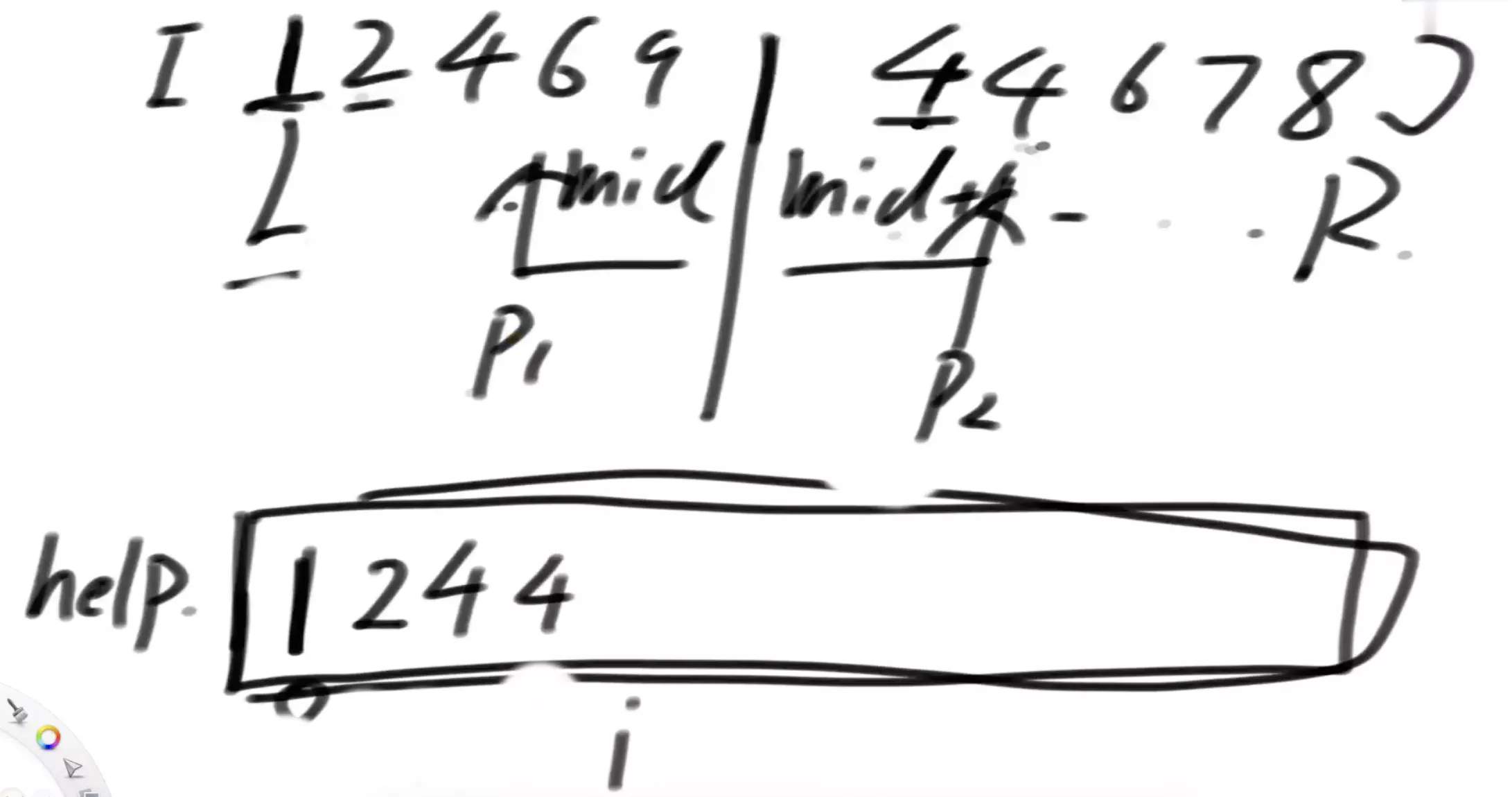
- 非递归版本

/**
* 归并排序
* O(nlogN)
*/
public class _01_MergeSort {
// ------------------- 递归(二分处理) -------------------
/**
* 递归方法实现
*/
public static void mergeSort1(int[] arr) {
if (arr == null || arr.length < 2) {
return;
}
process(arr, 0, arr.length - 1);
}
/**
* arr[L...R]范围上的数,有序!
*/
public static void process(int[] arr, int L, int R) {
// L R 上只有一个数,不需要排序,直接返回
if (L == R) {
return;
}
// int mid = (L + R) / 2 可能越界,写法更安全
int mid = L + ((R - L) >> 1);
process(arr, L, mid);
process(arr, mid + 1, R);
merge(arr, L, mid, R);
}
/**
* 将左右排序好的数组合并 => O(n)
*
* @param arr arr 待排序数组
* @param L L 左下标
* @param M M 中下标
* @param R R 右下标
*/
public static void merge(int[] arr, int L, int M, int R) {
// 辅助数组
int[] help = new int[R - L + 1];
int i = 0;
int p1 = L;
int p2 = M + 1;
// 都不越界
while (p1 <= M && p2 <= R) {
help[i++] = arr[p1] <= arr[p2] ? arr[p1++] : arr[p2++];
}
// 要么p1越界,要么p2越界。只会中一个
// 不可能出现:共同越界
while (p1 <= M) {
help[i++] = arr[p1++];
}
while (p2 <= R) {
help[i++] = arr[p2++];
}
for (i = 0; i < help.length; i++) {
arr[L + i] = help[i];
}
}
// ------------------- 非递归(步长处理) -------------------
/**
* 归并排序(非递归实现,手敲版)=> O(nlogN)
*/
public static void mergeSort2(int[] arr) {
if (arr == null || arr.length < 2) {
return;
}
// 步长
int step = 1;
int N = arr.length;
// 步长 == 总长度,右边已经没有数据了
while (step < N) {
int L = 0;
while (L < N) {
int M;
// 规避 M 越界
// (N - 1) - L + 1
if (N - L >= step) {
M = L + step - 1;
} else {
M = N - 1;
}
if (M == N - 1) {
break;
}
int R;
// 规避 R 越界
// (N - 1) - (M + 1) + 1
if (N - 1 - M >= step) {
// R = (M + 1) + step - 1;
R = M + step;
} else {
R = N - 1;
}
merge(arr, L, M, R);
// 下一个L
if (R == N - 1) {
break;
} else {
L = R + 1;
}
}
// 防止step溢出,必须是>,(N / 2)向下取整
if (step > N / 2) {
break;
}
step *= 2;
}
}
/**
* 归并排序(非递归实现,标准版)
*/
public static void mergeSort3(int[] arr) {
if (arr == null || arr.length < 2) {
return;
}
int N = arr.length;
int mergeSize = 1;
while (mergeSize < N) {
int L = 0;
while (L < N) {
if (mergeSize >= N - L) {
break;
}
int M = L + mergeSize - 1;
int R = M + Math.min(mergeSize, N - M - 1);
merge(arr, L, M, R);
L = R + 1;
}
if (mergeSize > N / 2) {
break;
}
mergeSize <<= 1;
}
}
// ------------------- 对数器 -------------------
public static int[] generateRandomArray(int maxSize, int maxValue) {
int[] arr = new int[(int) ((maxSize + 1) * Math.random())];
for (int i = 0; i < arr.length; i++) {
arr[i] = (int) ((maxValue + 1) * Math.random()) - (int) (maxValue * Math.random());
}
return arr;
}
public static int[] copyArray(int[] arr) {
if (arr == null) {
return null;
}
int[] res = new int[arr.length];
System.arraycopy(arr, 0, res, 0, arr.length);
return res;
}
public static boolean isEqual(int[] arr1, int[] arr2) {
if ((arr1 == null && arr2 != null) || (arr1 != null && arr2 == null)) {
return false;
}
if (arr1 == null && arr2 == null) {
return true;
}
if (arr1.length != arr2.length) {
return false;
}
for (int i = 0; i < arr1.length; i++) {
if (arr1[i] != arr2[i]) {
return false;
}
}
return true;
}
public static void printArray(int[] arr) {
if (arr == null) {
return;
}
for (int j : arr) {
System.out.print(j + " ");
}
System.out.println();
}
public static void main(String[] args) {
int testTime = 500_000;
int maxSize = 100;
int maxValue = 100;
System.out.println("测试开始");
for (int i = 0; i < testTime; i++) {
int[] arr1 = generateRandomArray(maxSize, maxValue);
int[] arr2 = copyArray(arr1);
mergeSort1(arr1);
mergeSort2(arr2);
if (!isEqual(arr1, arr2)) {
System.out.println("出错了!");
printArray(arr1);
printArray(arr2);
break;
}
}
System.out.println("测试结束");
}
}
5. 快速排序
- <=区、>区
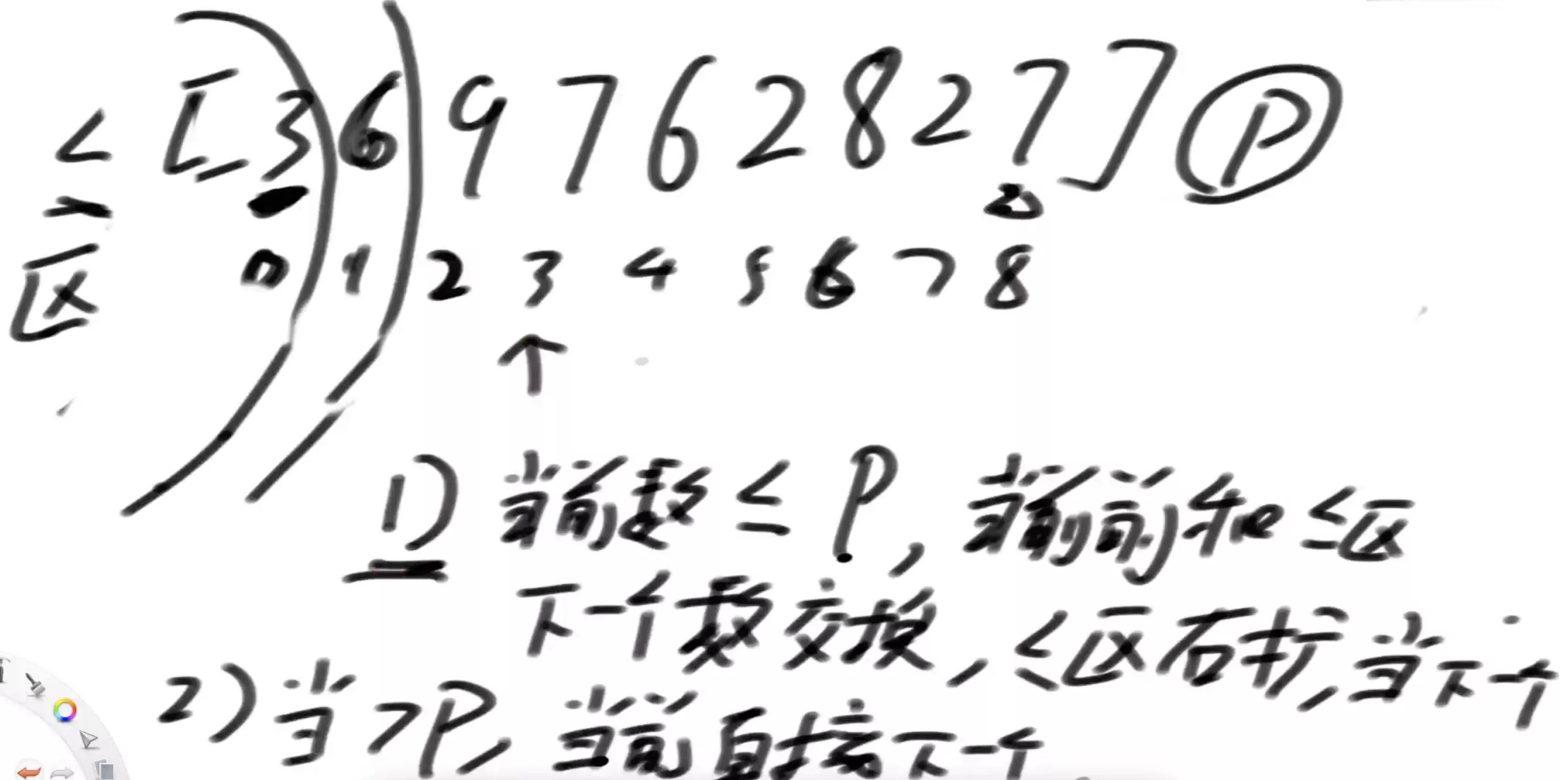
- <区、=区、>区
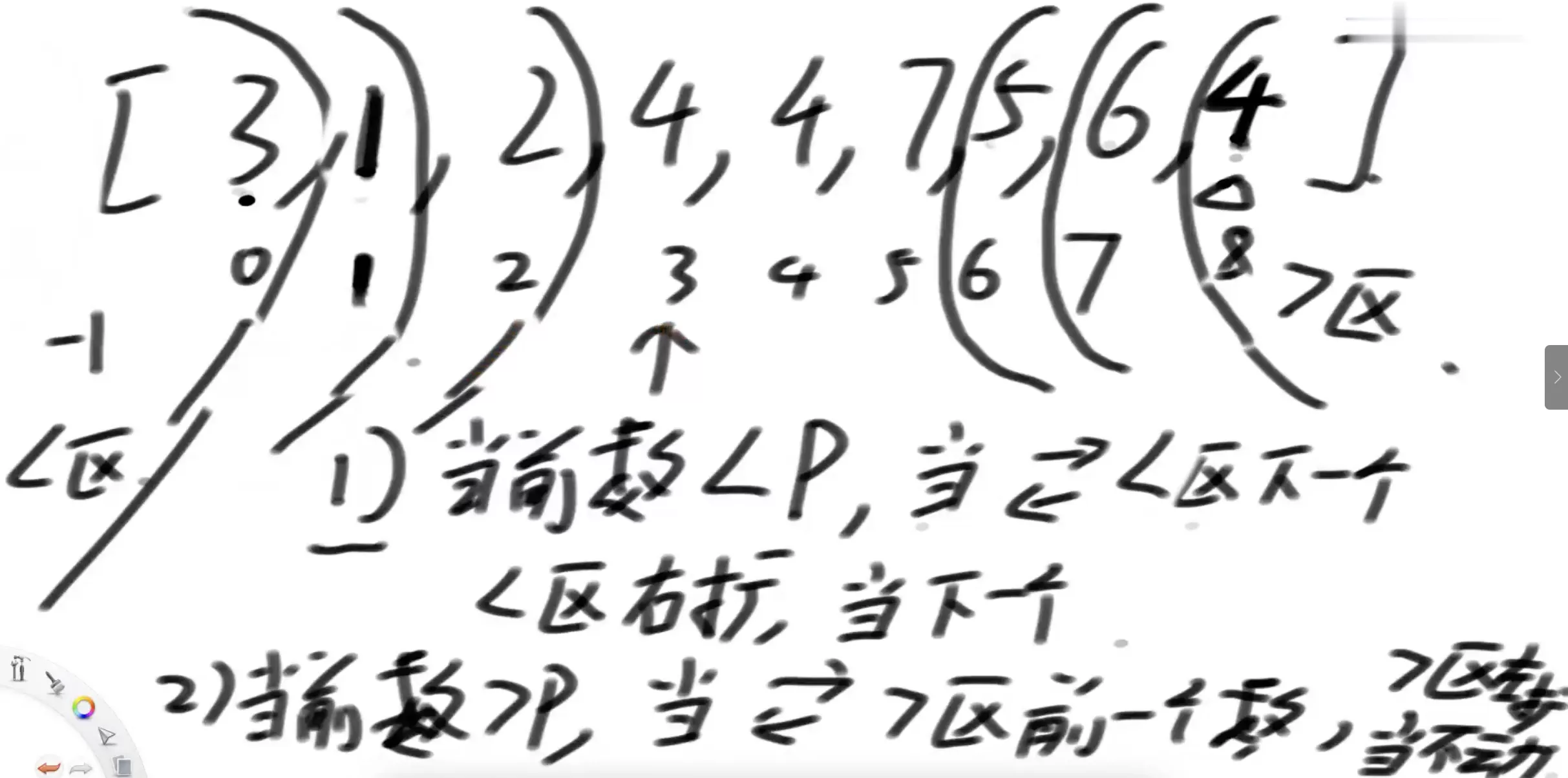
- 快速排序原理。不断得在
<区、>区进行区域划分
public class _02_PartitionAndQuickSort {
/**
* [3 6 9 7 6 2 8 2 7]
* 一个数组中:<= 放左边,> 放右边。内部可以无序
*/
public static void splitNum1(int[] arr) {
// 小于等于区下标
int lessEqualR = -1;
int index = 0;
int N = arr.length;
while (index < N) {
if (arr[index] <= arr[N - 1]) {
// 当前值和<=区的下一个交换
swap(arr, ++lessEqualR, index++);
} else {
index++;
}
}
}
/**
* [3 4 4 6 4 7 0 1 5 2 4]
* 一个数组中:< 放左边,= 放中间,> 放右边。内部可以无序
*/
public static void splitNum2(int[] arr) {
int N = arr.length;
int lessR = -1;
int moreL = N - 1;
int index = 0;
// arr[N-1] 划分值
while (index < moreL) {
// curr和<区下一个交换,<区扩充
if (arr[index] < arr[N - 1]) {
swap(arr, ++lessR, index++);
}
// curr和<区下一个交换,<区扩充
else if (arr[index] > arr[N - 1]) {
swap(arr, --moreL, index);
}
// 直接下一个
else {
index++;
}
}
swap(arr, moreL, N - 1);
}
public static void swap(int[] arr, int i, int j) {
int tmp = arr[i];
arr[i] = arr[j];
arr[j] = tmp;
}
// ---------------------------------------------------------------
/**
* arr[L...R]范围上,拿arr[R]做划分值
* L....R `<区、=区、>区1`
* int[] => 等于区左右边界
*/
public static int[] partition(int[] arr, int L, int R) {
if (L > R) {
return new int[]{-1, -1};
}
if (L == R) {
return new int[]{L, R};
}
int lessR = L - 1;
int moreL = R;
int index = L;
while (index < moreL) {
if (arr[index] < arr[R]) {
swap(arr, ++lessR, index++);
} else if (arr[index] > arr[R]) {
swap(arr, --moreL, index);
} else {
index++;
}
}
swap(arr, moreL, R);
return new int[]{lessR + 1, moreL};
}
// ---------------------------------------------------------------
/**
* 递归快排
*/
public static void quickSort1(int[] arr) {
if (arr == null || arr.length < 2) {
return;
}
process(arr, 0, arr.length - 1);
}
/**
* 不断对`<区、>区`进行递归快速排序。=区已经排好确定
*/
public static void process(int[] arr, int L, int R) {
if (L >= R) {
return;
}
// 随机确定一个最右数
swap(arr, L + (int) (Math.random() * (R - L + 1)), R);
int[] equalE = partition(arr, L, R);
// equalE[0] 等于区域第一个数
process(arr, L, equalE[0] - 1);
// equalE[1] 等于区域最后一个数
process(arr, equalE[1] + 1, R);
}
// ------------------------------ 非递归快排 ------------------------------
public static class Job {
public int L;
public int R;
public Job(int left, int right) {
L = left;
R = right;
}
}
/**
* 非递归快排
*/
public static void quickSort2(int[] arr) {
if (arr == null || arr.length < 2) {
return;
}
Stack<Job> stack = new Stack<>();
stack.push(new Job(0, arr.length - 1));
while (!stack.isEmpty()) {
Job cur = stack.pop();
int[] equals = partition(arr, cur.L, cur.R);
// 有 < 区域
if (equals[0] > cur.L) {
stack.push(new Job(cur.L, equals[0] - 1));
}
// 有 > 区域
if (equals[1] < cur.R) {
stack.push(new Job(equals[1] + 1, cur.R));
}
}
}
// ----------------------------- 对数器 -----------------------------
public static int[] generateRandomArray(int maxSize, int maxValue) {
int[] arr = new int[(int) ((maxSize + 1) * Math.random())];
for (int i = 0; i < arr.length; i++) {
arr[i] = (int) ((maxValue + 1) * Math.random()) - (int) (maxValue * Math.random());
}
return arr;
}
public static int[] copyArray(int[] arr) {
if (arr == null) {
return null;
}
int[] res = new int[arr.length];
System.arraycopy(arr, 0, res, 0, arr.length);
return res;
}
public static boolean isEqual(int[] arr1, int[] arr2) {
if (arr1 == null && arr2 == null) {
return true;
}
if (arr1 == null ^ arr2 == null) {
return false;
}
if (arr1.length != arr2.length) {
return false;
}
for (int i = 0; i < arr1.length; i++) {
if (arr1[i] != arr2[i]) {
return false;
}
}
return true;
}
// ---------------------------------------------------------------------
public static void main(String[] args) {
int[] arr = {7, 1, 3, 5, 4, 5, 1, 4, 2, 4, 2, 4};
// <区, =区, >区
splitNum2(arr);
for (int j : arr) {
System.out.print(j + " ");
}
System.out.println("===========================");
int testTime = 500_000;
int maxSize = 100;
int maxValue = 100;
boolean succeed = true;
System.out.println("test begin");
for (int i = 0; i < testTime; i++) {
int[] arr1 = generateRandomArray(maxSize, maxValue);
int[] arr2 = copyArray(arr1);
int[] arr3 = copyArray(arr1);
quickSort1(arr1);
quickSort2(arr2);
if (!isEqual(arr1, arr2) || !isEqual(arr1, arr3)) {
System.out.println("Oops!");
succeed = false;
break;
}
}
System.out.println("test end");
System.out.println(succeed ? "Nice!" : "Oops!");
}
}
4. 数据结构
- 数据结构是存储、组织数据的方式
- 精心选择的数据结构,可以带来更高的运行、存储效率
- 数据结构是很多算法得以进行的载体
最基本的数据结构
- 数组(便于寻址,不便于增、删数据)
- 链表(便于增、删数据,不便于寻址)
1. 前缀和数组
- 求:
sum(arry, index1, index2)
1. 二维数组
(3, 4, 2, 1, 6, 7, 8)
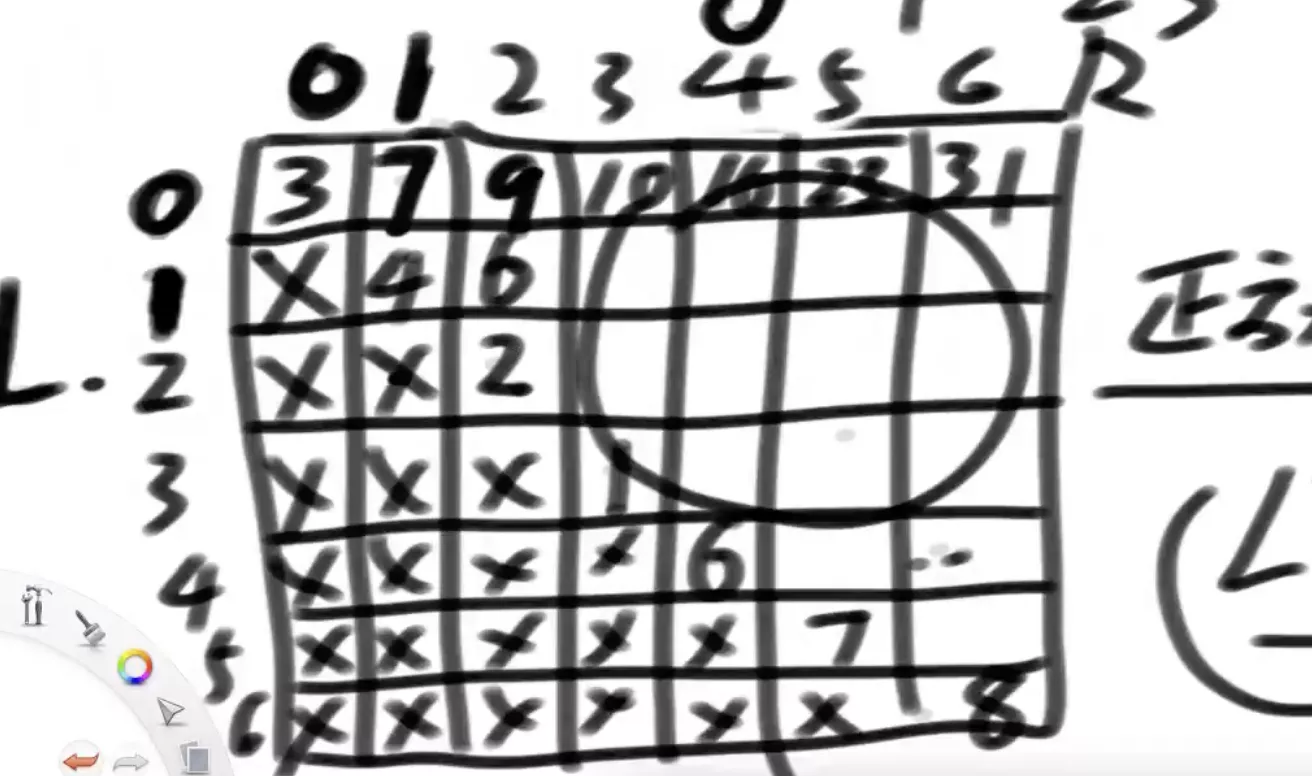
2. 一维数组
sum(arry, index1, index2) = sum(arry, 0, index2) - sum(arry, 0, index1)
/**
* 一段数组arr和
*/
public class _01_PreSum {
/**
* 1. 普通累加
*/
public static class RangeSum1 {
private final int[] arr;
public RangeSum1(int[] array) {
arr = array;
}
public int rangeSum(int L, int R) {
int sum = 0;
for (int i = L; i <= R; i++) {
sum += arr[i];
}
return sum;
}
}
/**
* 2. 前缀和
*/
public static class RangeSum2 {
// 构造前缀数组
private final int[] preSum;
public RangeSum2(int[] array) {
int N = array.length;
preSum = new int[N];
preSum[0] = array[0];
for (int i = 1; i < N; i++) {
preSum[i] = preSum[i - 1] + array[i];
}
}
public int rangeSum(int L, int R) {
return L == 0 ? preSum[R] : preSum[R] - preSum[L - 1];
}
}
}
2. 随机函数
Math.random()Math.random() * 8(int) (Math.random() * K)[0,x) 的概率 (x -> x^2)从a~b随机等概率,到c~d随机等概率[0, 1]不等概率 -> [0, 1]等概率
public class _02_RandToRand {
private static final int testTimes = 10_000_000;
/**
* Math.random()
*/
@Test
public void test1() {
// Math.random() -> double -> [0, 1)
// 等概率随机返回一个,数学上是做不到的,计算机是有精度的
int count = 0;
for (int i = 0; i < testTimes; i++) {
if (Math.random() < 0.75) {
count++;
}
}
System.out.println((double) count / (double) testTimes);
}
/**
* Math.random() * 8
*/
@Test
public void test2() {
// [0, 1) -> [0, 8)
int count = 0;
for (int i = 0; i < testTimes; i++) {
if (Math.random() * 8 < 5) {
count++;
}
}
System.out.println((double) count / (double) testTimes);
System.out.println((double) 5 / (double) 8);
}
/**
* [0, K) -> [0, K-1]
* (int) (Math.random() * K)
*/
@Test
public void test3() {
int K = 9;
int[] counts = new int[9];
for (int i = 0; i < testTimes; i++) {
int ans = (int) (Math.random() * K);
counts[ans]++;
}
for (int i = 0; i < K; i++) {
System.out.println(i + " 这个数,出现了 " + counts[i] + " 次");
}
}
// ----------------------------------------------------------------------------
/**
* [0,x) 的概率 (x -> x^2)
*/
@Test
public void test4() {
int count = 0;
double x = 0.17;
for (int i = 0; i < testTimes; i++) {
if (xToXPower2() < x) {
count++;
}
}
System.out.println((double) count / (double) testTimes);
System.out.println(Math.pow(x, 2));
}
/**
* 返回[0,1)的一个小数
* 任意的x,x属于[0,1),[0,x)范围上的数出现概率由原来的x调整成x^2
*/
public static double xToXPower2() {
return Math.max(Math.random(), Math.random());
}
public static double xToXPower3() {
return Math.max(Math.random(), Math.max(Math.random(), Math.random()));
}
// ----------------------------------------------------------------------------
/**
* 从a~b随机等概率,到c~d随机等概率
*/
@Test
public void test5() {
int count = 0;
for (int i = 0; i < testTimes; i++) {
if (f2() == 0) {
count++;
}
}
System.out.println((double) count / (double) testTimes);
int[] counts = new int[8];
for (int i = 0; i < testTimes; i++) {
// int num = f3();
// int num = f4();
int num = g();
counts[num]++;
}
for (int i = 0; i < 8; i++) {
System.out.println(i + "这个数,出现了 " + counts[i] + " 次");
}
}
/**
* lib里的,不能改!
* 等概率[1, 5]
*/
public static int f1() {
return (int) (Math.random() * 5) + 1;
}
/**
* 随机机制,只能用f1
* 等概率[0, 1]
*/
public static int f2() {
int ans;
do {
ans = f1();
} while (ans == 3);
// 1,2 => 0
// 4,5 => 1
return ans < 3 ? 0 : 1;
}
/**
* 得到000 ~ 111
* 等概率[0, 7]
*/
public static int f3() {
return (f2() << 2) + (f2() << 1) + f2();
}
/**
* 等概率[0, 6]
*/
public static int f4() {
int ans;
do {
ans = f3();
} while (ans == 7);
return ans;
}
/**
* 等概率[1, 7]
*/
public static int g() {
return f4() + 1;
}
// ------------------------------------------------------------
/**
* [0, 1]不等概率 -> [0, 1]等概率
*/
@Test
public void test6() {
int count = 0;
for (int i = 0; i < testTimes; i++) {
if (y() == 0) {
count++;
}
}
System.out.println((double) count / (double) testTimes);
}
/**
* 你只能知道,x会以固定概率返回0和1,但是x的内容,你看不到!
*/
public static int x () {
return Math.random() < 0.84 ? 0 : 1;
}
/**
* 等概率返回0和1
*/
public static int y() {
int ans;
do {
ans = x();
} while (ans == x());
// ans = 0 1
// ans = 1 0
return ans;
}
// ------------------------------------------------------------
// 这个结构是唯一的随机机制
// 只能初始化并使用,不可修改
public static class RandomBox {
private final int min;
private final int max;
// 初始化时请一定不要让mi==ma
public RandomBox(int mi, int ma) {
min = mi;
max = ma;
}
// 13 ~ 17
// 13 + [0,4]
public int random() {
return min + (int) (Math.random() * (max - min + 1));
}
public int min() {
return min;
}
public int max() {
return max;
}
}
// 利用条件RandomBox,如何等概率返回0和1
public static int rand01(RandomBox randomBox) {
int min = randomBox.min();
int max = randomBox.max();
// min ~ max
int size = max - min + 1;
// size是不是奇数,odd奇数
boolean odd = (size & 1) != 0;
int mid = size / 2;
int ans;
do {
ans = randomBox.random() - min;
} while (odd && ans == mid); // 奇数且等于中间数
return ans < mid ? 0 : 1;
}
// 给你一个RandomBox,这是唯一能借助的随机机制
// 等概率返回from~to范围上任何一个数
// 要求from<=to
public static int random(RandomBox randomBox, int from, int to) {
if (from == to) {
return from;
}
// (3 ~ 9) => (0 ~ 6)
// 0 ~ range
int range = to - from;
int num = 1;
// 求0~range需要几个2进制位
while ((1 << num) - 1 < range) { // 全是1的二进制数,
num++;
}
// 一共需要num位
// 最终的累加和。首先:0位上1或0,1位上1或0,2位1或0...
int ans;
do {
ans = 0;
for (int i = 0; i < num; i++) {
ans |= (rand01(randomBox) << i);
}
} while (ans > range); // 超出部分舍弃
return ans + from;
}
}
[0, 1]不等概率 -> [0, 1]等概率
public class _04_EqualProbabilityRandom {
// 内部内容不可见
public static int f() {
return Math.random() < 0.8 ? 0 : 1;
}
// 等概率返回 0,1
public static int g() {
int first;
do {
first = f(); // 0,1
} while (first == f());
return first;
}
// 这个结构是唯一的随机机制
// 只能初始化并使用,不可修改
public static class RandomBox {
private final double p;
// 初始化时请一定满足:(0 < zeroP < 1)
public RandomBox(double zeroP) {
p = zeroP;
}
public int random() {
return Math.random() < p ? 0 : 1;
}
}
// 底层依赖一个以p概率返回0,以1-p概率返回1的随机函数rand01p
// 如何加工出等概率返回0和1的函数
public static int rand01(RandomBox randomBox) {
int num;
do {
num = randomBox.random();
} while (num == randomBox.random());
return num;
}
public static void main(String[] args) {
// (0, 1)
int[] count = new int[2];
for (int i = 0; i < 1_000_000; i++) {
int ans = g();
count[ans]++;
}
System.out.println(count[0] + ", " + count[1]);
double zeroP = 0.88;
RandomBox randomBox = new RandomBox(zeroP);
System.out.println("------------------------------------------------");
int testTime = 10_000_000;
int num = 0;
for (int i = 0; i < testTime; i++) {
if (rand01(randomBox) == 0) {
num++;
}
}
System.out.println((double) num / (double) testTime);
}
}
3. 对数器
- 选择、冒泡、插入排序的对数器验证
public class _03_Comp {
public static void swap(int[] arr, int i, int j) {
int tmp = arr[i];
arr[i] = arr[j];
arr[j] = tmp;
}
// 1. 选择排序
public static void selectionSort(int[] arr) {
if (arr == null || arr.length < 2) {
return;
}
for (int i = 0; i < arr.length - 1; i++) {
int minIndex = i;
for (int j = i + 1; j < arr.length; j++) {
if (arr[j] < arr[minIndex]) {
minIndex = j;
}
}
swap(arr, i, minIndex);
}
}
// 2. 插入排序
public static void insertionSort(int[] arr) {
if (arr == null || arr.length < 2) {
return;
}
for (int i = 1; i < arr.length; i++) {
// 0 ~ i 有序
for (int j = i - 1; j >= 0 && arr[j] > arr[j + 1]; j--) {
swap(arr, j, j + 1);
}
}
}
// ---------------------------------------------------------------
@Test
public void test() {
int maxLen = 5;
int maxValue = 1_000;
int testTime = 10_000;
for (int i = 0; i < testTime; i++) {
int[] arr = lenRandomValueRandomArray(maxLen, maxValue);
// 备份
int[] tmp = copyArray(arr);
selectionSort(arr);
if (!isSorted(arr)) {
// 打印备份,找到错误例子
for (int k : tmp) {
System.out.print(k + " ");
}
System.out.println();
System.out.println("选择排序错了!");
break;
}
}
}
/**
* 随机数组(长度、值 随机)
* 返回一个数组arr,arr长度[0, maxLen-1],arr中的每个值[0, maxValue-1]
*/
public static int[] lenRandomValueRandomArray(int maxLen, int maxValue) {
int len = (int) (Math.random() * maxLen);
int[] ans = new int[len];
for (int i = 0; i < len; i++) {
ans[i] = (int) (Math.random() * maxValue);
}
return ans;
}
/**
* copyArray
*/
public static int[] copyArray(int[] arr) {
int[] ans = new int[arr.length];
System.arraycopy(arr, 0, ans, 0, arr.length);
return ans;
}
/**
* 排序验证,后一个大于前一个
*/
public static boolean isSorted(int[] arr) {
if (arr.length < 2) {
return true;
}
int max = arr[0];
for (int i = 1; i < arr.length; i++) {
if (max > arr[i]) {
return false;
}
max = Math.max(max, arr[i]);
}
return true;
}
}
5. 二分法
1. 找num
- arr有序,找num
public class _01_BSExist {
/**
* 二分法在数组中,查找元素
*/
public static boolean find(int[] arr, int num) {
if (arr == null || arr.length == 0) {
return false;
}
int L = 0;
int R = arr.length - 1;
while (L <= R) {
int mid = (L + R) / 2;
if (arr[mid] == num) {
return true;
} else if (arr[mid] < num) {
L = mid + 1;
} else {
R = mid - 1;
}
}
return false;
}
/**
* 对数器
*/
public static boolean test(int[] sortedArr, int num) {
for (int cur : sortedArr) {
if (cur == num) {
return true;
}
}
return false;
}
/**
* 生成随机数组
*/
public static int[] generateRandomArray(int maxSize, int maxValue) {
int[] arr = new int[(int) ((maxSize + 1) * Math.random())];
for (int i = 0; i < arr.length; i++) {
arr[i] = (int) ((maxValue + 1) * Math.random()) - (int) (maxValue * Math.random());
}
return arr;
}
/**
* 有序数组中找到num
*/
public static void main(String[] args) {
int testTime = 500_000;
int maxSize = 10;
int maxValue = 100;
boolean succeed = true;
for (int i = 0; i < testTime; i++) {
int[] arr = generateRandomArray(maxSize, maxValue);
Arrays.sort(arr);
int value = (int) ((maxValue + 1) * Math.random()) - (int) (maxValue * Math.random());
if (test(arr, value) != find(arr, value)) {
System.out.println("出错了!");
succeed = false;
break;
}
}
System.out.println(succeed ? "Nice!" : "Fucking fucked!");
}
}
2. >=num最左index
public class _02_BSNearLeft {
/**
* arr有序,>=num 最左index
*/
public static int mostLeftNoLessNumIndex(int[] arr, int num) {
if (arr == null || arr.length == 0) {
return -1;
}
int L = 0;
int R = arr.length - 1;
int ans = -1;
while (L <= R) {
int mid = (L + R) / 2;
if (arr[mid] >= num) {
ans = mid;
R = mid - 1;
} else {
L = mid + 1;
}
}
return ans;
}
/**
* 对数器
*/
public static int test(int[] arr, int value) {
for (int i = 0; i < arr.length; i++) {
if (arr[i] >= value) {
return i;
}
}
return -1;
}
public static int[] generateRandomArray(int maxSize, int maxValue) {
int[] arr = new int[(int) ((maxSize + 1) * Math.random())];
for (int i = 0; i < arr.length; i++) {
arr[i] = (int) ((maxValue + 1) * Math.random()) - (int) (maxValue * Math.random());
}
return arr;
}
public static void printArray(int[] arr) {
if (arr == null) {
return;
}
for (int j : arr) {
System.out.print(j + " ");
}
System.out.println();
}
/**
* 有序数组中,找到>=num最左的位置
*/
public static void main(String[] args) {
int testTime = 500_000;
int maxSize = 10;
int maxValue = 100;
boolean succeed = true;
for (int i = 0; i < testTime; i++) {
int[] arr = generateRandomArray(maxSize, maxValue);
Arrays.sort(arr);
int value = (int) ((maxValue + 1) * Math.random()) - (int) (maxValue * Math.random());
if (test(arr, value) != mostLeftNoLessNumIndex(arr, value)) {
printArray(arr);
System.out.println(value);
System.out.println(test(arr, value));
System.out.println(mostLeftNoLessNumIndex(arr, value));
succeed = false;
break;
}
}
System.out.println(succeed ? "Nice!" : "Fucking fucked!");
}
}
3. 局部最小
- 定义:
[0] < [1][N-2] < [N-1]左 < [i] < 右
- 返回一个局部最小
public class _04_BSAwesome {
/**
* arr 整体无序
* arr 相邻的数不相等!
*/
public static int oneMinIndex(int[] arr) {
if (arr == null || arr.length == 0) {
return -1;
}
int N = arr.length;
if (N == 1) {
return 0;
}
if (arr[0] < arr[1]) {
return 0;
}
if (arr[N - 1] < arr[N - 2]) {
return N - 1;
}
int L = 0;
int R = N - 1;
// L...R 肯定有局部最小
// 1. (R - 1) 确保三个节点,才进入while体
while (L < R - 1) {
int mid = (L + R) / 2;
if (arr[mid] < arr[mid - 1] && arr[mid] < arr[mid + 1]) {
return mid;
} else {
if (arr[mid] > arr[mid - 1]) {
R = mid - 1;
} else {
L = mid + 1;
}
}
}
// 2. 只有两个数
return arr[L] < arr[R] ? L : R;
}
/**
* 生成随机数组,`相邻数不相等`
*/
public static int[] randomArray(int maxLen, int maxValue) {
int len = (int) (Math.random() * maxLen);
int[] arr = new int[len];
if (len > 0) {
arr[0] = (int) (Math.random() * maxValue);
for (int i = 1; i < len; i++) {
do {
arr[i] = (int) (Math.random() * maxValue);
} while (arr[i] == arr[i - 1]);
}
}
return arr;
}
/**
* 对数器
*/
public static boolean check(int[] arr, int minIndex) {
if (arr.length == 0) {
return minIndex == -1;
}
int left = minIndex - 1;
int right = minIndex + 1;
// boolean leftBigger = left >= 0 ? arr[left] > arr[minIndex] : true;
boolean leftBigger = left < 0 || arr[left] > arr[minIndex];
// boolean rightBigger = right < arr.length ? arr[right] > arr[minIndex] : true;
boolean rightBigger = right >= arr.length || arr[right] > arr[minIndex];
return leftBigger && rightBigger;
}
public static void printArray(int[] arr) {
for (int num : arr) {
System.out.print(num + " ");
}
System.out.println();
}
public static void main(String[] args) {
int maxLen = 100;
int maxValue = 200;
int testTime = 1_000_000;
System.out.println("测试开始");
for (int i = 0; i < testTime; i++) {
int[] arr = randomArray(maxLen, maxValue);
int ans = oneMinIndex(arr);
if (!check(arr, ans)) {
printArray(arr);
System.out.println(ans);
break;
}
}
System.out.println("测试结束");
}
}
6. 时间复杂度
1. 常数操作
+, -, *, /, arr[x]和数据量无关的去处,都是常数操作- 复杂度:
2. 引入
- 冒泡排序、选择排序 =>
- 不关心低阶项,也不关心系数
- 二分查找 =>
- 最差情况下的复杂度
3. 常见复杂度
- 稳定:如果a原本在b前面,而a=b,排序之后a仍然在b的前面
- 不稳定:如果a原本在b的前面,而a=b,排序之后a可能会出现在b的后面
- 内排序:所有排序操作都在内存中完成
- 外排序:由于数据太大,因此把数据放在磁盘中,而排序通过磁盘和内存的数据传输才能进行
- 时间复杂度:一个算法执行所耗费的时间
- 空间复杂度:运行完一个程序所需内存的大小
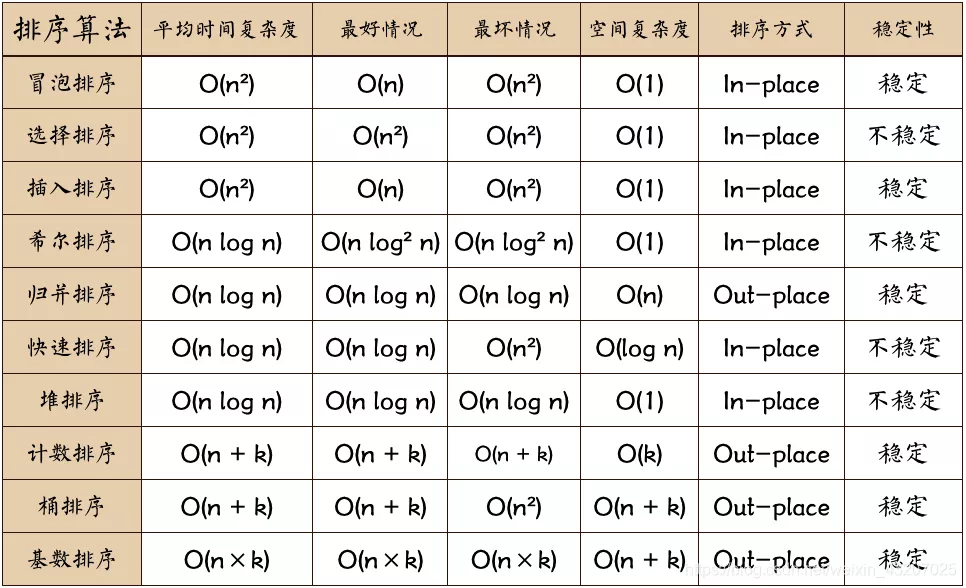
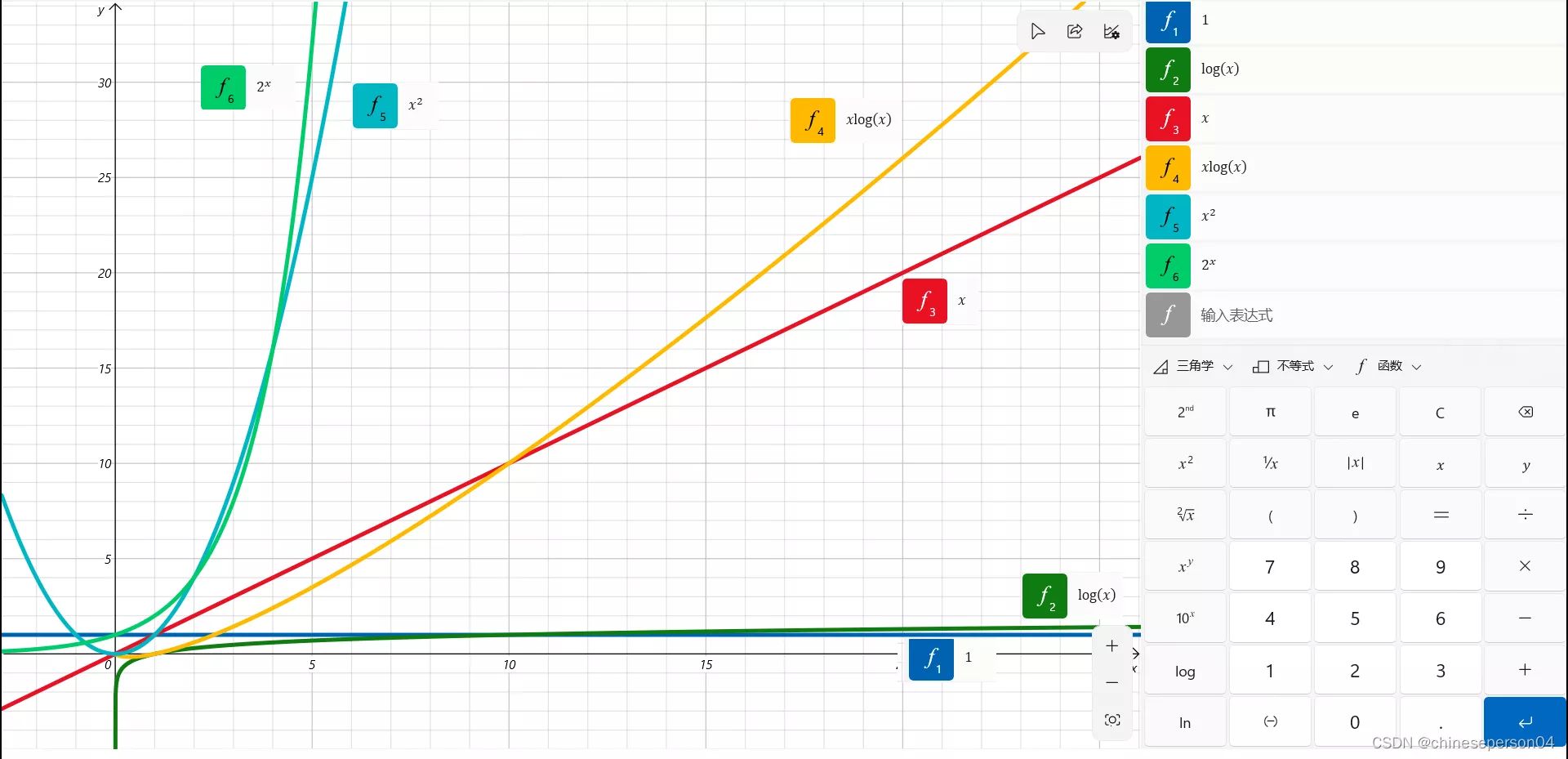
4. 动态数组
ArrayList动态扩容1 + 2 + 4 + 8 + ... + N等比数列 => ,均摊下来
5. 哈希表
- 增删查改均为: 👍。比较大的常数时间(相比,数组寻址、
+, -, *, /)
public static class Node {
public int value;
public Node(int v) {
value = v;
}
}
/**
* (K V)表
* 1. 哈希表(hashMap)
* 2. 有序表(treeMap)
*/
@Test
public void test1() {
// 1. 增删查改:O(1),只是每次操作都慢一些(相对于数组寻址,`+, -, *, /`)
HashMap<String, String> map = new HashMap<>();
map.put("ooxx", "我是ooxx");
System.out.println(map.containsKey("ooxx"));
System.out.println(map.get("ooxx"));
map.put("ooxx", "他是ooxx");
System.out.println(map.get("ooxx"));
map.remove("ooxx");
System.out.println(map.get("ooxx"));
// 2. 值传递 hashMap占用内存为 key + value
HashMap<Integer, String> map2 = new HashMap<>();
map2.put(1234567, "我是1234567");
Integer a = 1234567;
Integer b = 1234567;
// 内存地址
System.out.println(a == b);
// hash表里`Integer, Double, Float, String`按值传递
System.out.println(map2.containsKey(a));
System.out.println(map2.containsKey(b));
// 3. 引用传递 hashMap占用内存为(key引用 + value引用),16字节
// 非原生类型,按引用传递,对象内存地址作为key。重写hashCode()另算
Node node1 = new Node(1);
Node node2 = new Node(1);
HashMap<Node, String> map3 = new HashMap<>();
map3.put(node1, "我进来了!");
System.out.println(map3.containsKey(node1));
System.out.println(map3.containsKey(node2));
}
6. 有序表
- 增删查改均为:
@Test
public void test2() {
// 1. 增删查改:O(logN)
TreeMap<Integer, String> treeMap = new TreeMap<>();
treeMap.put(3, "我是3");
treeMap.put(0, "我是3");
treeMap.put(7, "我是3");
treeMap.put(2, "我是3");
treeMap.put(5, "我是3");
treeMap.put(9, "我是3");
System.out.println(treeMap.containsKey(7));
System.out.println(treeMap.containsKey(6));
System.out.println(treeMap.get(3));
treeMap.put(3, "他是3");
System.out.println(treeMap.get(3));
treeMap.remove(3);
System.out.println(treeMap.get(3));
System.out.println(treeMap.firstKey());
System.out.println(treeMap.lastKey());
// <=5 离5最近的key告诉我
System.out.println(treeMap.floorKey(5));
// <=6 离6最近的key告诉我
System.out.println(treeMap.floorKey(6));
// >=5 离5最近的key告诉我
System.out.println(treeMap.ceilingKey(5));
// >=6 离6最近的key告诉我
System.out.println(treeMap.ceilingKey(6));
// cannot be cast to java.lang.Comparable
// 2. key 必须是可比较的。构造方法必须自定义
Node node3 = new Node(3);
Node node4 = new Node(4);
TreeMap<Node, String> treeMap1 = new TreeMap<>();
treeMap1.put(node3, "我是node3");
treeMap1.put(node4, "我是node4");
}